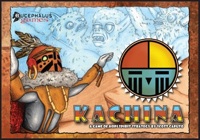by Demian Katz
 Kachina
Kachina
Published by Bucephalus Games
Designed by Scott Caputo
Illustrated by Andy Hopp
Art Direction by Zannah Aensland
Graphic Layout by Andy Hopp, Phil Lacefield Jr. and Dan Tibbles
60 Kachina tiles, 1 score board, 5 player aid cards, 5 score markers, 1 rulebook
2-5 players
$19.99
This game is featured in the OgreCave Christmas Gift Guide 2009
Since being pleasantly surprised by Toboggans of
Doom, the last Bucephalus Games release I tried, I've been
looking forward to trying more of the young but prolific company's
output. Fortunately, Kachina is another success; it shares the
high production quality of Toboggans while providing
significantly meatier gameplay.
Gameplay
The theme of the game involves a battle for dominance between Kachina
(spirits from Hopi legend). However, this is a Euro-style game, so the
theme isn't particularly significant except to add some flavor. At its
heart, this is an abstract strategic tile-laying game. Each player has
a hand of five tiles representing Kachina. There are eight types of
tiles with different numeric value, and the six lowest-valued types have
special abilities to balance out their lower values. Tiles are played
to the table in interlocking rows and columns, so a game of
Kachina can end up looking somewhat like a game of
Scrabble. There can only be a maximum of seven tiles in a row or
column, and some tile abilities place further limitations on placement.
Players score points by dominating rows or columns - the more tiles in a
dominated area, the more points are scored. Dominance is usually
achieved by playing the highest-numbered tile in the group, but some
special powers offer different ways of dominating. Hummingbird tiles,
for example, are weak by themselves but can dominate a row by bookending
it. Wolves are more powerful in large groups. Eagles and Warriors are
able to remove or override stronger tiles.
The game sounds fairly simplistic when summarized, but it proves to be
more interesting than it sounds in actual play. Although there are only
six special abilities, they offer a wide variety of strategies. You can
blockade areas, change the values of adjacent tiles, and steal tiles
from the board into your hand. It takes a good eye and careful planning
to maximize your score, and it's quite satisfying when you're finally
able to make a play that connects two rows together or scores big points
at an intersection between a row and column. Although there is some
luck of the draw involved, the fact that every player has a hand of
tiles reduces the luck factor significantly; this is largely a game of
skill. If you're looking for a serious strategy game with a lot of
possibilities and not too many rules, you could certainly do a lot worse
than this one.
Presentation
Kachina is a good game on its own, but the presentation here
helps it shine. A game like Kachina can be ruined if players are
unable to easily keep track of all the different tile abilities, and the
design here makes sure that will not be a problem. All of the tiles
have icons to help explain the abilities, and every player has a
reference card featuring the full ability text from the rulebook. As
with Toboggans of Doom, all of the cardboard components are thick
and sturdy... even the reference cards! This game should stand up to a
lot of use. The packaging is impressive, too; there is a tendency to
put games in boxes that are too big just to make them stand out on the
shelf. Kachina wisely avoids this annoying decision, instead
providing a modestly-sized box with a nice cardboard insert that helps
everything stack neatly inside. I have only two complaints. First of
all, the scoring markers are all identical except for color; this will
cause problems for the color-blind, and the red and orange shades are
close enough to cause problems for everyone. Not a big deal since the
markers are easily replaced, but variety in pattern as well as color
would have been a nice touch. Secondly, I'm not sure I'm a fan of the
high-gloss finish on the cardboard - I think the textured matte finish
found in most German games looks a little nicer. These are very minor
points, though, and overall, I think Bucephalus has gotten almost
everything right.
Conclusions
That's two wins in a row for Bucephalus, by my reckoning. I hope they can keep up the
pattern of high-quality games at reasonable prices; they seem to be on
the right track to becoming a significant player in the game world. As
for Kachina itself, it's the sort of game that could benefit from
expansion sets in the future (hear that, Bucephalus?), but even if that
never happens, it's a strong strategy game that's well worth checking
out, and I'm glad to have added it to my collection.
| Related reviews on OgreCave: |
|
|


 Kachina
Kachina